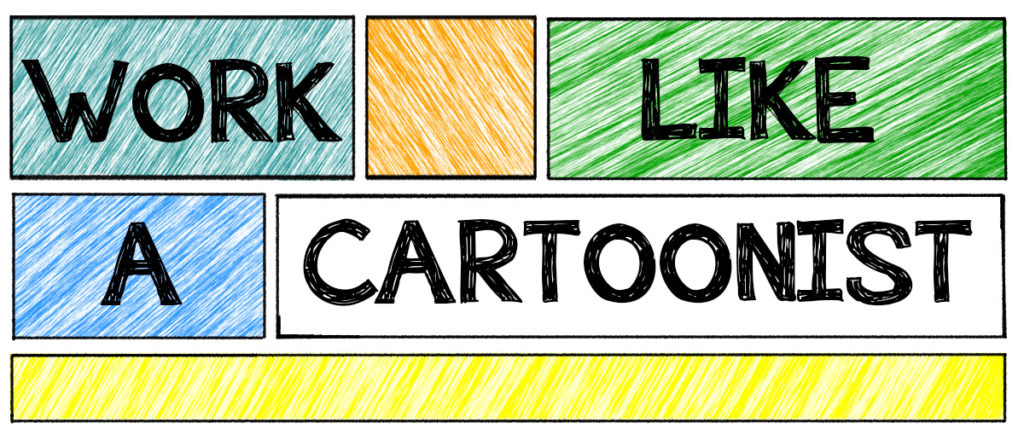Charles Schulz – the creator of Charlie Brown, Snoopy, and the whole Peanuts gang – taught me how to read when I was three-years-old.
These were the days when most people got their news from a combination of the daily newspaper and Walter Cronkite. Every day, after the grown-ups were done with the news, I would pour over the comics page. On Sundays, there was an entire SECTION of comics in the paper. And it was in color!
At three, I enjoyed the cartoons themselves, but I really wanted to be able to understand what that round-headed kid and his dog were saying. Depending on the day, my mom or aunts or uncles or grandparents would read the comics to me and guide me along as I started to learn. But it was Good Ol’ Charlie Brown who showed up every single day with something new to say that inspired me to make reading a daily habit that stuck with me for well over four decades.
I decided I wanted to be a cartoonist when I grew up. Drawing four small pictures and scribbling out a few words didn’t seem like it would take very long or be very hard. My naive concept of how cartoonists worked enchanted me. Make people laugh for a living and do a whole week’s worth of work in one day! What could be better? Even if my idealized version had been correct, there was still one major flaw…
I couldn’t draw. At all. To this day, even a game of Hangman is an artistic challenge for me.
While my dream of becoming the next Charles Schulz never made it off the drawing board, my love of the comics and something about the way a cartoonist works has remained. In the ensuing years, I’ve learned more about the reality of their work process, but the fascination has stuck with me. Recently I wondered, “What if I work like a cartoonist, but instead of drawing, I apply it to writing?”
I began the process a month ago and launched earlier this week.
How they do it
A cartoonist starts with a “gag” – the punch line or joke. They then draw out the rough sketch. Next they finalize and ink that sketch. Finally, they add the color and ship it. This is the basic framework, but each cartoonist works a little differently. Some will batch the work and take a week’s worth or more of strips through each step in the process at the same time, while others will work solely on one strip from start to finish before they move on to the next one.
How I’ll do it
For this blog, I take a similarly segmented approach. I’ll start with an idea for a post. When an idea hits, no matter where I am or what I’m doing, I make an entry in Evernote, capturing enough about the idea so that if I come back to it 3 months later I’ll know what I was thinking. And, yes, I have been guilty of this while standing at a urinal.
Next, I open a Google calendar where I’ve slotted future posts for the next three weeks. If it’s an idea I want to explore and capture immediately, I’ll find a good spot for it on the calendar and “schedule it.” If the post is scheduled within the next two weeks, I’ll open up a template I’ve created in MS Word and build an outline of the post.
In a separate work session, I’ll look at my calendar and fully complete the next incomplete post on the schedule. Right now, I’m staying about 1-2 weeks out.
The Sunday Notes posts (like this one) are a bit different as they are much longer and include more than one topic. I usually have 2-3 of those going at once and will use the weekend one week out to put all of the finishing touches on the main point and then use the rest of the week to round out the “notes” section that follows the main point.
My plan for publishing the posts is to match comic strips when it comes to the format of the week. Monday through Saturday will be shorter and more straight-forward posts. Inspired by the incredible talents of Bill Watterson and Peter Gammons, Sundays posts will be longer-form content where I hope to push myself beyond my own abilities and create something unique. I want it to stand out from not only the rest of the week, but the typical blog post as well.
If I keep up the seven posts a week schedule going forward, it will take me approximately another 49 years to equal Charles Schulz’s prolific output. While my wife would be happy to see me live to be 99-years-old, my doctor doesn’t like my chances. My mental healthcare providers are even more pessimistic.
In addition to Charles Schulz, there are some other mentors to thank (or blame) for this idea.
Peter Gammons:
Peter Gammons’s legendary “Sunday Notes” columns from his heyday in the sports section of the Boston Globe became mandatory reading for me once it was online and I became aware of it. I have blatantly borrowed the title and will also be liberally borrowing from the format. There will be one main story that will be a part of the title (“Work Like A Cartoonist” from today, for example), to be followed by miscellaneous short notes and observations from the week. I also reserve the right, during the baseball season, to add some thoughts about my beloved Red Sox, which is the whole reason I became acquainted with the amazing work of Peter Gammons to begin with.
Bill Watterson:
Though I grew up with Peanuts, my favorite comic strip is far and away Bill Watterson’s Calvin and Hobbes. The strip launched on November 18, 1985 when I was 17. I remember first seeing it in the spring of 1986 and I was hooked with the first Sunday panel I read. Two different Calvin and Hobbes strips I cut out of the Enid Morning News & Daily Eagle on the day they originally ran now hang in my son’s bedroom; the newsprint – and the jokes – surviving more than thirty years. I didn’t just hand down the strips themselves, I also handed down my love for that stuffed tiger and his best friend.
Watterson’s ability to capture truth, build an entire world, and make a personal connection in just a few panels was like nothing I had ever seen before (or since). The personal standard of excellence he held himself to with each strip he delivered ensured that he never gave less than his best on a single frame of Calvin. To claim that Watterson’s standards have informed mine would smack of hubris, but it’s a mountain I long to climb. A tall order I know, but ignorance breeds courage.
Seth Godin:
Author and marketing guru, Seth Godin provided the final piece of the puzzle. He first blogged online in 2002 and sometime in 2004 he committed to publishing a post every single day. He’s now at somewhere north of 7,000 blog posts. It’s a backlist that impresses not just with the sheer quantity, but also the incredible quality he has delivered. He also managed to publish a dozen or so books during the same time frame.
The discipline of writing and publishing 365 days a year leads to craftsmanship that is impossible to gain any other way. I don’t know that I can sustain it for fourteen years (and counting) the way Seth has, but I’m hopeful I can do it for at least five. Seth’s prolific output reconnected me to the cartoonist dreams of my youth.
Like Good ‘Ol Charlie Brown, he shows up every day.
NOTES:
Our family has been rewatching News Radio this summer. My oldest son is a big Joe Rogan fan (Rogan has sure found himself in the actual news this week), and we all love Stephen Root’s Jimmy James, but the star of the show in our household without question is Phil Hartman’s Bill McNeal. Which bring me to this week’s completely random and highly subjective Top 10 list:
Top 10 Television Characters – Comedy (alphabetic order):
- Michael Bluth (Arrested Development)
- David Brent (The Office – BBC)
- Archie Bunker (All In The Family)
- Frasier Crane (Cheers, Frasier)
- Captain Raymond Holt (Brooklyn 99)
- Leslie Knope (Parks and Rec)
- Bill McNeal (News Radio)
- Hawkeye Pierce (M*A*S*H)
- Lucy Ricardo (I Love Lucy)
- Homer Simpson (the Simpsons)
The internet will undoubtedly agree with that definitive list in its entirety, so I’ll move on.
New Book Spotlight:
Seth Godin continues to crank out a blog post every day, creates new programs like the Bootstrapper’s Workshop, records a world-class podcast, and still manages to find time to write books. This is Marketing: You Can’t Be Seen Until You Learn To See – Godin’s first book since 2015’s Poke The Box – arrives later this year on November 13th.
I’m mentioning the book now, two months before it’s available, because there are sometimes as many lessons in the way Godin markets his books as there are in the book itself.
Regarding the book itself, the man who invented the phrase “Permission Marketing,” returns to his core philosophy: that powerful marketing is grounded in empathy, generosity, and emotional labor; that you can’t obtain permission until you build trust.
Godin is required reading for anyone involved in marketing and if you’re an entrepreneur or a freelancer, you might want to read him as well. There’s a good chance your competition is.
The Struggle:
As a baseball fan, I like stats. I like stats a lot. This is great when it comes to following the Red Sox, but is unproductive when it comes to my own career.
There are 29 email subscribers to this site as I write this. That number is disappointing (to put it mildly), but it’s EXACTLY the number deserved for someone who – before this week – posted a grand total of ONE blog post over the previous 375 days. Email subscribers, Facebook likes, Twitter followers, etc., etc., etc. It feels like I’ve been checking my stats this week as much as I’ve been writing.
The struggle this week has been to remain focused on the work and not the results. It’s not about the stats this year, much less this week. It’s about building a body of work and improving my craft day over day, week over week, month over month, and year over year. I’ve felt frustration at posting for several days in a row and not perceptibly moving the needle. I’ve had to continually remind myself – that’s not the point and it’s too early. I haven’t earned anything yet.
It’s not about one post being a “hit.” I’ll take the hits if they come, but I’d rather take stock of my career in five or ten or twenty years and have it look more like Tom Waits than Psy.
All of that being said, it would be nice to hit 30 subscribers. Not that I’ll be looking.
Quotes:
You will find your own ethical dilemmas in all parts of your lives, both personal and professional. We all have different desires and needs, but if we don’t discover what we want from ourselves and what we stand for, we will live passively and unfulfilled. Sooner or later, we are all asked to compromise ourselves and the things we care about. We define ourselves by our actions. With each decision, we tell ourselves and the world who we are. Think about what you want out of this life, and recognize that there are many kinds of success.
Bill Watterson
If you’re going to draw a comic strip every day, you’re going to have to draw on every experience in your life
Charles Schulz
End Credits:
My uniquely talented bride created the title graphic at the top of the page. It’s an homage to the documentary Stripped, a great film about comic strips that was funded via Kickstarter. You can check it our yourself here. The movie poster for Stripped features Bill Watterson’s first cartoon art in over twenty years.








0 Comments